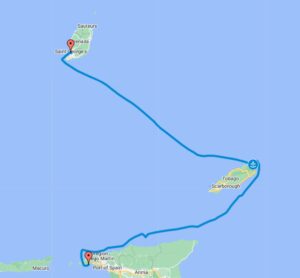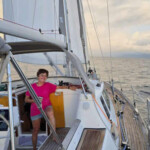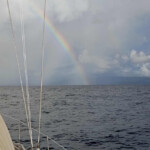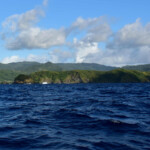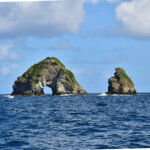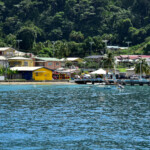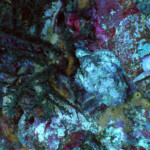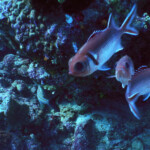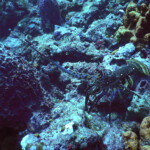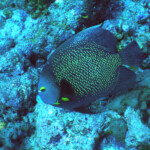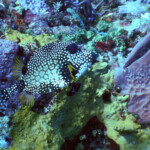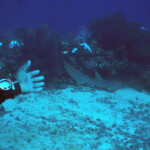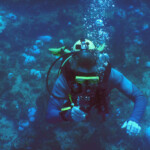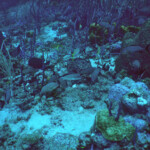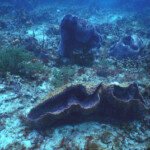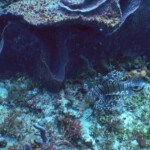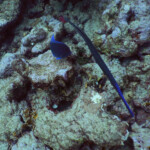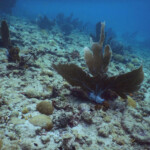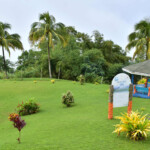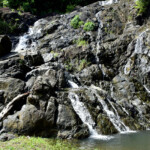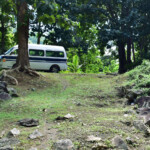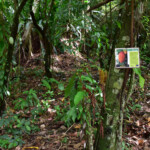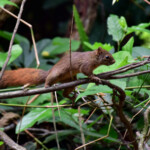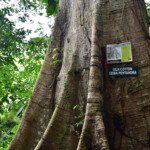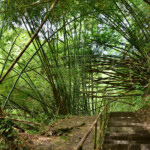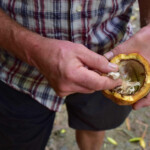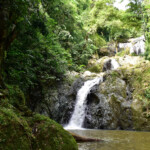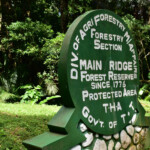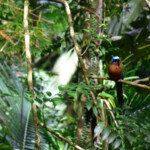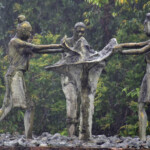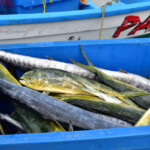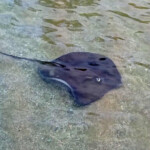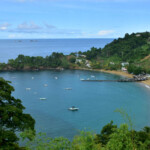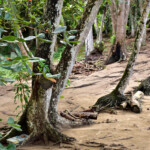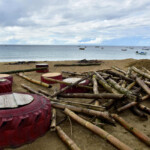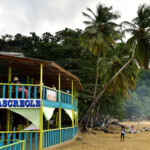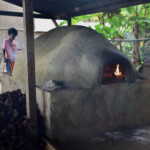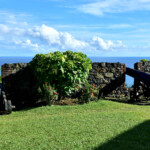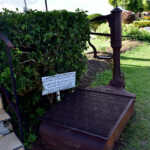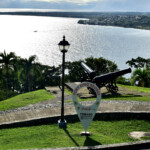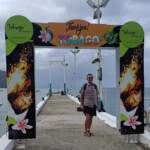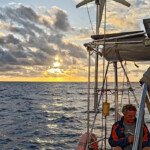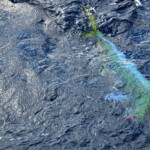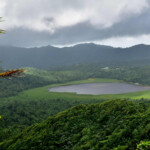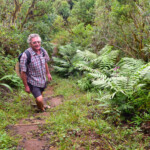Route: Chaguaramas(Trynidad) – Charlotteville (Tobago) – St. George (Grenada)
Dates: 09-13.12.2024
Miles/ hours: 181Mm/40h
Trinidad
Trip to Pitch Lake.
We set off from the marina gate at 9 am. We drive across the entire island for almost 100 km, over 2 hours. We travel by bus with 8 other sailors from other yachts. The tour operator is Jassy James. On the way, Jessy buys us Indian rolls baked with vegetables – delicious, and for dessert, Indian cookies.
We reach the lake. A lady guide is waiting for us there. The Pitch Lake stretches across the entire town, but asphalt is extracted only in one area. There are 3 such lakes in the world, but asphalt is extracted only from this one (or rather pitch, or tar – this is what asphalt is made from).
The reservoir is the largest natural deposit of this black goo in the world. It is located near the town of La Brea (maybe that’s where the term “breja” comes from?). It has an area of 4 hectares, and its depth reaches up to 76 meters. The local asphalt was used to pave several of the first paved streets in New York and to cover Washington’s Pennsylvania Avenue, where the White House stands. The “deposit” is still being exploited, and since 1978 it has been done under the brand name of the company “Lake Asphalt of Trinidad and Tobago”.
Probably, as scientists from the United States Geological Survey claim, the tar is pushed to the surface here due to the favorable arrangement of faults. The appropriate pressure and arrangement of permeable and impermeable layers can lead to spontaneous outflows of crude oil.
However, under the influence of the hot climate and strong sun (we are almost in the equatorial zone), the oil loses its volatile components, leaving behind heavier asphalt.
The guide takes us to the middle of the lake. During the rainy season, it is filled with water, which is pumped out to extract the tar. You have to be careful, because the bottom is very uneven and it is easy to fall into a hole and into waist-deep water. The dug-out tar is loaded into special wagons that are taken to a plant where the tar is turned into asphalt. Asphalt is exported all over the world, and the largest recipient is China. Engineers supervise the extraction of asphalt, making sure not to dig in the same place for too long. After digging the right amount of tar in the same place, you can only start digging after a month.
After visiting the lake and the museum, we go to eat something. Jessie buys roti – a flatbread with filling – you can choose vegan, with chicken or goat. Very tasty and filling, although difficult to eat.
Temple at Sea
The Temple at Sea – an inconspicuous chapel at sea has a very moving story. Seedas Sadhu was a simple Hindu worker who dreamed of creating a place of worship in his new homeland. He built his first temple in 1947, but the same authorities who sold him the land ordered it to be dismantled. So he decided to build another one on the sea, which belongs to no one. All he had was a bicycle and an old bag in which he carried stones to build a causeway and foundations. When the tide went out, he would set up heavy barrels, but the tides destroyed his efforts. The determined Sadhu did not give up for 40 years, until the end of his life.
There are many birds in the area, and in the evening, when the waters recede, the ibises come – the national birds of Trinidad.
Jaya Guru Datta Jai Sita Ram Jai Hanuman Temple
We visit the Hindu temple of Jaya Guru Datta Jai Sita Ram Jai Hanuman. is one of the most famous religious sites in Trinidad, there is an 85-foot Hanuman murthi – supposedly the largest outside of India. The entire temple and the surrounding buildings, including the decorations, were made by hand. There is a dress code, which means women must have their arms and legs covered.
A trip to the market
After signing up for the list last week, we set off from the Power Boat marina. There are 4 buses going. It takes us about ½ hour to get to the market. We get off the buses and agree to meet in about 1 hour at the parking lot. There are a lot of vegetables and fruits at the market, although we don’t see any mangoes, but there are vegetables and fruits familiar to us from Cuba (ampalaya – a cucumber with protuberances, chayote – edible chayote and many others). Due to the short time, we only buy a few things (and it still comes to about 16 kg) and return to the bus. Transport costs 25 TT$ per person.
Haul out
At 1015, the travellift operator (Omar) came by and said that he could pull us out. We enter the dock through the stern. We have to remove the Wi-Fi antenna and lower the fan as much as possible. Just barely, but we fit. At 1115 we are already on land. They put blocks under the keel and start doing other work. One stays and starts scraping the bottom. Then he brings a pressure washer with a combustion engine and starts washing. At 17 he finishes work, but promises to come the next day. I make an appointment with Mark for antifouling painting on Friday
Work on land
18-10-2024 Friday
In the morning, Mark comes with a black guy from Tobago and they start sanding – mostly black guy, and the guy with the pressure washer shows up at 830 instead of 7, but finishes washing the hull. The black guy sands until the evening (i.e. until 17).
19-10-2024 Saturday
I’ve been running around the shops since morning and buying antifouling thinner, rollers and a pad (after washing with a pressure washer some of the antifouling came off). The little guy finishes sanding and paints with a pad.
20-10-2024 Sunday
The little guy has been painting with antifouling since morning, then together with Mark they move the supports and paint the places where the supports were.
Trip to ASA Wright Nature Center
The trip is organized by Jasse James. We start at 8:15 from Marina. We drive to the north of the island to the center.
Asa Wright Nature Center and Lodge is a nature center and research station in Arima Valley in the Northern Range of Trinidad and Tobago. The center is one of the best places for birdwatching in the Caribbean; a total of 256 species of birds have been recorded there. The center is owned by a non-profit organization.
The nature center covers an area of 270 acres (110 ha) and includes the main house with an inn and restaurant.
After arriving at the center, we go on a guided tour. The guide shows us various plants and birds and tells us about their habits. The path is for American tourists – comfortable and wide. After an hour’s walk, we return the same way. A buffet lunch awaits us. Everything is delicious and even Tomek eats. For dessert, cake, ice cream and coffee.
After lunch, we go to see the natural pool with a waterfall – it is tiny, and the waterfall is not big either. We do not swim. We return to the center. For afternoon tea, coffee from a local plantation with homemade cookies. We watch a film about the creation of the center – the current owners bought the ruined center, renovated it, made hiking paths, bird feeders, information boards, etc. They tried to preserve the original character of the buildings. After afternoon tea and watching the film, we return to the marina.
Divali, a Hindu festival of light
In the afternoon, we go to Divali, organized by the local Hindu community for sailors. There is rotti, a local Indian food – in polystyrene packaging we get various vegetable mixtures and pancakes, for those willing there are even spoons, and some bring their own cutlery. Everything is very tasty. Then they light clay lamps placed on bent bamboo stalks.
Divali in Felicity
Divali in the city of Felicity. We travel by buses from the marina. The whole thing is organized by Jessy. Over 60 people from several marinas are traveling. It takes about 1 hour to get to Felicity. After arriving, we first watch performances in the temple. Before entering the temple, you have to take off your shoes, women must have their shoulders and knees covered, and men must have long trousers. The performance lasts about half an hour – first a dancer dances, then a small band performs, and then another dancer. Everything is related to Divali.
The essence of Diwali, also known as the festival of lights, is to celebrate the triumph of light over darkness, or good over evil.
Diwali celebrations are exceptionally joyful. Hindus spend this time praying for health and prosperity, talking to loved ones and friends, enjoying sweet delicacies, dancing and singing.
After the performances, we go in groups to eat. The women have prepared traditional vegetarian rotti served on banana leaves. We eat with our hands. At the end, everyone gets a bag of Hindu sweets. After the meal, we go to the city, which is beautifully decorated with lights (they are just setting them up). There are “gates” of lights on the main street. On the side streets, there are signs drawn on the asphalt, lots of lights, firecrackers and some fireworks. They hand out bags of sweets on the streets, and we are even invited home. Unfortunately, there is not much time, so after about an hour we go to the bus and return to the marina.
Angostura Rum Factory.
You must sign up for the tour in advance via email at tours@angostura.com.
A minimum of 8 people in a group (then the tour costs 60TT$ per person). You can organize a group yourself and sign up for any date from 10am to 1pm from Monday to Friday, or join an existing group – that’s what we did. We drove to the factory for 90TT$ (30TTS per person) – at first we only wanted to go to Port of Spain (then it would have been 15TT$ per person), but there was an accident on the way, and the driver agreed to take us to the factory itself – we made it almost at the last minute. The tour is only with a guide. You can only pay for the tour and in the shop with local products by card.
First, we visit the butterfly exhibition – a unique collection of almost 5,000 specimens, mainly from Trinidad, but also from all over the world.
Then we go to the museum, where we learn about the history of the factory and the idea for the aromatic Angostura bitters.
The next stage is a tour of the factory – we move around the factory in an electric car. We watch as they fill the tanks with molasses (a new delivery has just arrived). The factory uses molasses deliveries from all over the Caribbean, because molasses is not produced in Trinidad (there are no sugar cane plantations). We see huge vats where molasses ferments, then distillation columns – they are huge.
We visit the “Bitter Room”, the only place in the world where bitters are produced this product.
The production of Angostura® aromatic bitters is shrouded in great secrecy, only 5 people in the company know the ingredients of the bitters and apparently no one in the company knows who they are. The ground and mixed herbs are mixed with rum and set aside to “infuse” the flavor for about 3 months.
The last stage is bottling and labeling. The bitter label is “historically” too big – a long time ago one person designed the bottle and another the label, but they did not reach an agreement, so the label came out too big and from then on it has been a characteristic of Angostura.
After the trip we buy a set of bitters and rum and then return to Chaguaramas. We catch a “private taxi” for 100 TT$.
Check out in Trinidad
First you have to visit immigration. The lady finds our papers from the boarding clearance, copies them, writes something on them, stamps them and hands us one copy stapled together to be forwarded to the inigration in Charlotteville. Then we go to customs – the gentleman on the big sheet from the boarding clearance adds that we are sailing to Charlotteville and also enters it in his journal.
We can sail.
The way from Trinidad to Tobago
We sail out before 11, sailing against the wind and current all the time. The current sometimes reaches 3kn. It is impossible to sail in the right direction with the opposite wind and such a strong current. We support ourselves with the engine. We sail all night. We sail around Tobago from the south. We reach Charlotteville at 10 am. We stand on a buoy.
Tobago
Customs clearance in Tobago
After launching the boat, we sail ashore and go to customs and immigration. The building is there, but there’s no one inside, and there are signs with phone numbers on the doors. We’re looking for someone who can call – first we choose the lady at the reception desk of the building next door. She calls Inigration – the nice lady says she’ll be there only on Thursday at 10 a.m., but that’s no problem, we can come with the papers on Thursday. Another visit to customs (the lady lives 3 houses away but she’s not at home at the moment). We call from the police station – the lady promises she’ll be there in half an hour. We wait.
In the meantime, we decide to visit the tourist information at the port, the information is there, but closed due to Covid and hasn’t opened yet. We go back to customs. The lady is just entering the building with her husband carrying a water dispenser. We check in immediately to leave. We enter December 13, because we can :-). The lady charges a fee for foreign customs clearance of 225 TT$ and 50 TT$ for a “cruising permit” for a month (without a landed residence permit). On Thursday we go to immigration and this time we manage to check in, but we have to enter the planned departure time no later than 24 hours after check in. We enter 6 a.m. and it’s ok.
Diving
We went diving with the Tobago Dive Experience office. We chose 2 dives – with equipment we paid $155 each. You can pay in cash and by card (then in TT$). The driver picks us up from Charlotteville and takes us to the office on the other side of the island.
The staff prepares and checks everything, unfortunately the pressure gauges only have a psi scale, but we manage. We also take a group of American divers (they came especially for the dive). There are 11 of us in total and 3 instructors – not bad.
First dive at the Specials site. The reef is beautiful. Lots of sponges, colorful fish, lots of lionfish (unfortunately), we see huge lobsters, moray eels, stonefish and at the end we admire a shark hidden under the reef.
After diving we swim up to get full tanks and leave the empty ones, drink water and eat cookies, and then head to The Beach. There is indeed a lot of sand at the bottom, but the reef is also beautiful. More lobsters (this time 3 next to each other), sponges with fish hidden inside.
A trip around the island
We arrange a trip around the island at the diving office. The trip costs 70 USD per person. We arrange to meet at 11, in the morning we still have to check in. A maxi taxi comes to pick us up – this time a blue one – they drive around Tobago. We have the whole bus to ourselves.
First we go to Flagstaff Hill – it is a viewpoint overlooking the ocean and Charlotteville, unfortunately on the Charlotteville side there is fog :-(, but the ocean on the other side is nicely visible.
This is an American relay station, but it was opened to the public in 1960 – the Americans left this point.
The next point is King’s Bay Falls, a nice waterfall with a small lake underneath. It used to be a large waterfall, but there was not enough water for the city, so they took some of it away :-(.
The flagship waterfall of Tobago is Argyle Falls, located in the national park – the entrance fee is 60TT$ per person. You have to walk a bit to the waterfall (about 15 minutes), there are signed trees along the way. You can also take a guide, for an additional fee, but then everything takes longer. The waterfall is really big (about 200m) and there is a 6m deep lake underneath, where you can swim.
Then we go to the rainforest This is the oldest reserve on the island – it was established in 1763. We see it from the car windows, it is very wet and you walk through the forest up to your knees in mud
In Parlatuvier Bay we watch huge rays. In the morning, when the weather is nice, you can swim with them. Local fishermen feed them, so they don’t run away. Unfortunately, the weather is rainy and feeding time has passed.
In Inglish man’s Bay, a beautiful bay with a small beach, we stop for lunch – of course fish with local additions (a little bit of everything) – various salads, lentils, baked bananas and various other delicacies.
The next point on the program is the town of Castreole – famous for its weekly bonfires (on Thursday evenings) and for baking delicious breadfruit – unfortunately, the season for these fruits does not start until mid-December.
On the way, we pass the Craig Hall waterfall and reach Scarborough, the capital of the island, the city is not huge, but it is extensive. We go up to Fort King George. We visit the fortifications, watch beautiful views from the top and return to Charlotteville. On the way, we also look at Rocky Bay.
The Way to Grenada
After lunch and spending the last of our Trinidadian dollars, we set off towards Grenada. We have a counter current again, but this time the wind is in our favor, so we sail about 6kn above the bottom (despite the counter current sometimes reaching 3kn.
Early in the morning we sail into Grenada to the Yacht Club marina.
Grenada
Grenada Yacht Club Marina
The marina is on the opposite side of the bay – opposite the Port Louis marina. Much closer to the city, with working internet and over 3 times cheaper. When staying for over 18 days, it is worth taking a monthly stay – then the stay for the whole month costs about $600 and additionally water and electricity according to the meters.
Check in
Customs and Immigration are in the same room (two separate desks) at the back of the marina office in Port Louis (about 10 minutes on foot. Sailclear works, it is worth filling out in advance. On site you have to pay 75EC$ for a cruising permit (valid for a month or until leaving Grenada – whichever comes first). Additionally, a fee 30EC$ per person (it has gone up in price) and 16.20EC$ port fee. You need to have passports of the entire crew, a Sailclear number and clearance documents from the previous port.
St. George Vegetable Market
Small, expensive (vegetable prices are a bit higher than in the supermarket), but there are a lot of different spices and this is probably the only reason to visit this market.
Trip to Grand Etang Lake and Mount Qua Qua
We set off in the morning from the bus station on bus no. 6 to the Grand Etang reserve. Grand Etang is a crater lake located at an altitude of 530m above sea level. It was created in the crater of the volcano that shaped Grenada. A reserve was created around the lake, admission 2USD or 5.5XCD per person
There is a footbridge – a viewpoint by the lake. A trail leading to Mount Qua Qua (715m) begins near the lake. The trail is very muddy and slippery (it is the end of the rainy season, so it is still raining). We walk along the crater crown, with precipices on both sides. Everything is overgrown, but from time to time there is a beautiful view of the lake below, the towns below and the green Grenada. The trail used to have steps, but sometimes there are planks left, and sometimes places dug in the clay for feet. It is very slippery and you need shoes with good soles.
At the top of the mountain there is a stone and a triangulation point. We eat sandwiches and drink coffee and set off down.
At the bottom we wash our feet in the lake and return by bus to St. George



